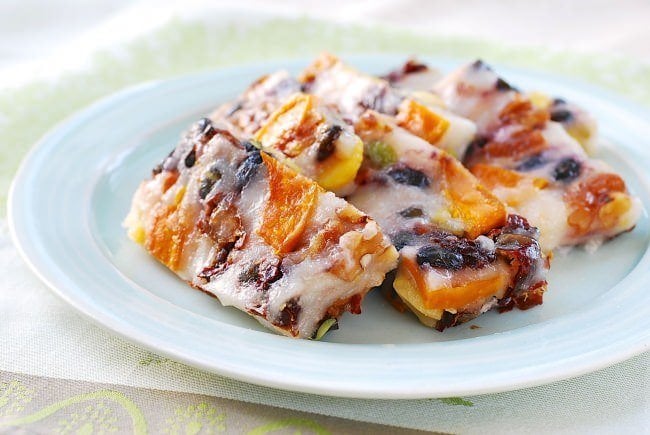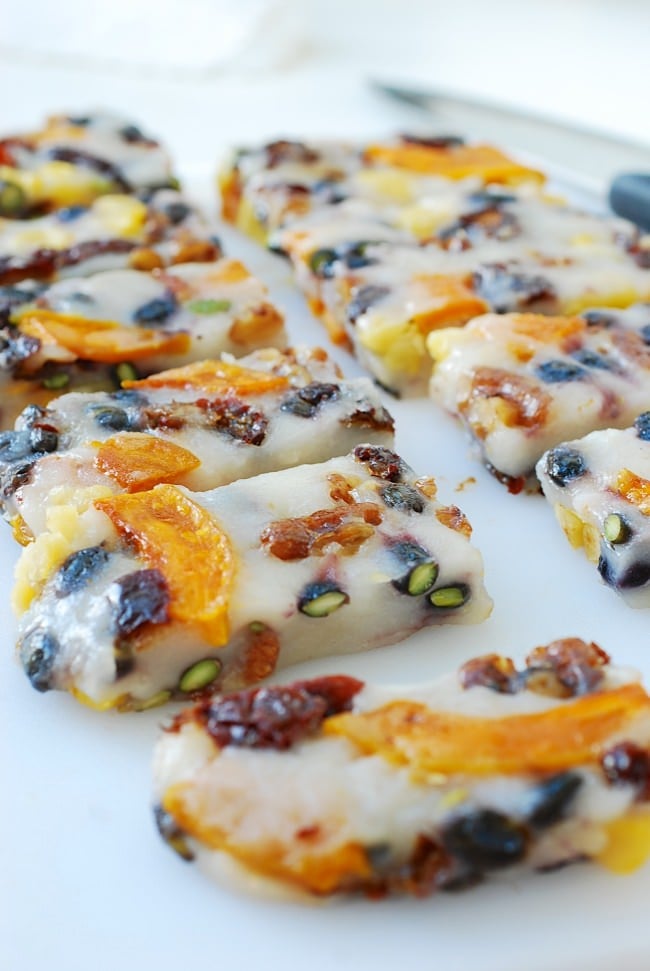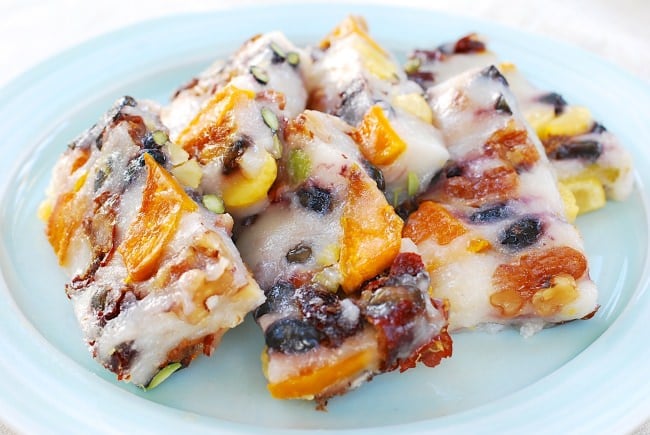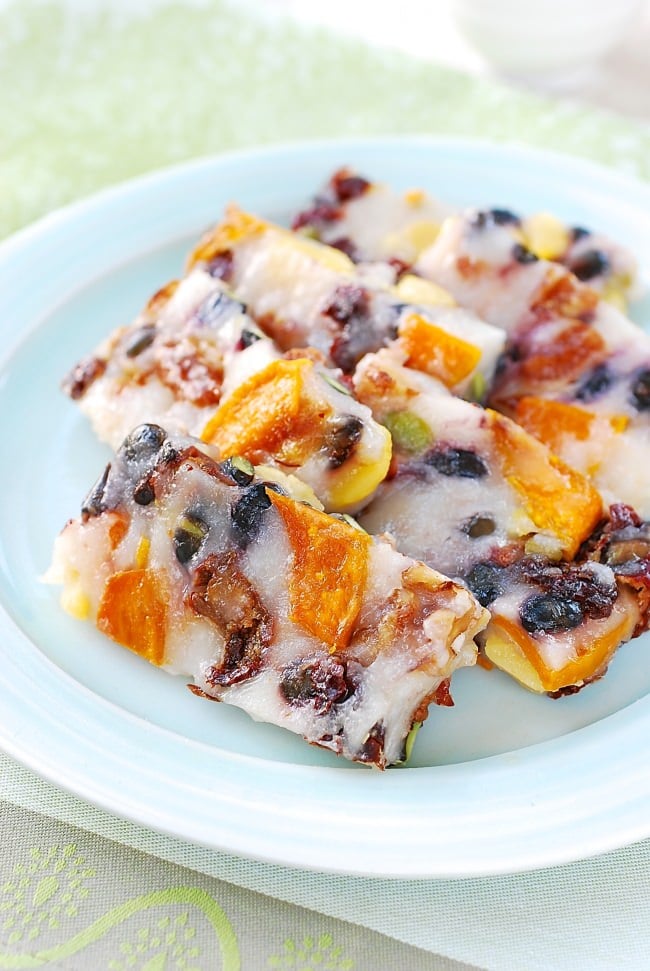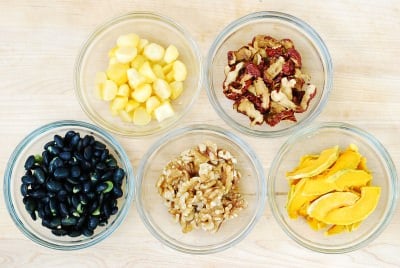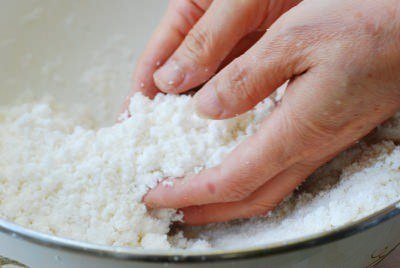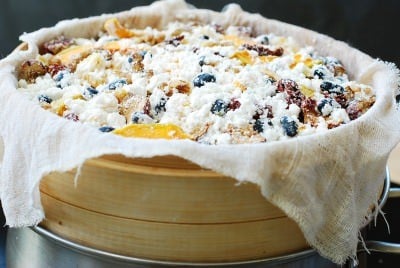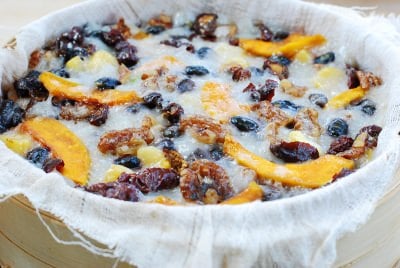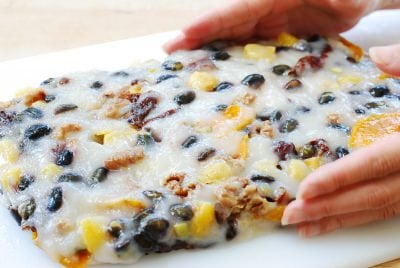This rice cake, youngyang chaltteok (영양 찰떡), is one of the easiest rice cakes you can make at home! No kneading, no shaping, no pounding, and no special tool other than a steamer is required! Young-yang means healthy, and chal-tteok refers to sticky, chewy rice cakes that are made with glutinous rice (sweet rice) flour/powder, chapssal garu (찹쌀가루). It’s also called by its short name youngyang tteok (or dduk).
The tradition of rice cakes goes back to ancient Korea. There are literally hundreds of varieties of rice cakes made with all sorts of grains. While enjoyed everyday as a snack, light meal, dessert, or in savory dishes such as tteokguk (soup), and tteokbokki (spicy stir-fried), rice cakes are a big part of the special occasion and holiday food traditions. For special days, Korean homes prepare several varieties of rice cakes in addition to the must-have type such as songpyeon for Chuseok (Korean thanksgiving/autumn harvest festival).
For this chaltteok, black soybeans (called seoritae, 서리태, or gumjeongkong, 검정콩 ), dried jujube (Korean dates, daechu, 대추), and dried pumpkin (hobak ogari, 호박오가리) are traditional ingredients. These days, it’s loaded with various nuts and/or other dried fruits such as raisins and dried persimmons (gotgam, 곶감), hence the name youngyang (healthy) tteok.
You can throw in any soaked dried beans, or even canned kidney beans (rinsed) instead of black soybeans. For nuts, I used chestnuts and walnuts. Other options are pecans, pistachios, pine nuts, pumpkin seeds, etc.
If you’re in Korea, new crop dried persimmons are in season by now, which will be excellent in this recipe. Also, dried pumpkin (hobak ogari) is commercially available in Korea, but not around here! So, I just slice up a kabocha and dry it in my dehydrator for a couple of hours. You can air dry them for a day or two if you don’t have a dehydrator. Dried pumpkin tastes sweeter and holds up its texture better when cooked.
I use frozen wet sweet rice powder (chapssal garu) that is available in the freezer section of Korean markets. If unavailable, you can make wet powder at home by soaking sweet rice and finely grinding in a blender.
Though not traditional, my secret ingredient is almond meal! One day, I added some almond meal, leftover from my daughter’s macaron baking, to use it up and really liked the results. It adds a nutty flavor to the rice cake while slightly loosening up the dense texture, but it’s absolutely optional!
This recipe is very flexible! You can vary the amounts of the rice powder or other ingredients. Any combination of sweet rice powder, some beans, nuts, and dried fruits will give you tasty, healthy rice cakes!


- 1 cup soaked black soybeans, seoritae, 서리태 (or kidney beans)
- 12 jujubes, dried Korean dates, daechu, 대추 (or 1/2 cup raisins, dried cranberries or persimmons)
- 1/2 cup dried kabocha (or other type of pumpkin) - optional - See note.
- 10 chestnuts, quartered
- 1/2 cup walnuts, quartered
- 5 cups frozen wet sweet rice flour, defrosted at room temperature - See note.
- 3 tablespoons sugar (2 tablespoons if you like it less sweet)
- 1/3 cup almond meal - optional
- Prepare the beans by soaking in warm water for a few hours. Rinse the jujubes and cut each one around the seed into 3 to 4 pieces. Rinse the optional dried kabocha and rehydrate by adding a tablespoon or two of water at a time, until softened. Prepare the nuts.
![Youngyang tteok (Korean Sweet Rice Cake)]()
- In a large bowl, combine the rice flour, sugar, and the optional almond meal. Mix well by hand or a whisk until everything is well incorporated. Add 2 tablespoons of water and rub the powder between your palms, breaking the big clumps, to evenly distribute the moisture. You don’t need to try to break up small clumps.
![Youngyang tteok (Korean Sweet Rice Cake)]()
- Add all the other ingredients and gently toss to combine everything.
![Youngyang tteok (Korean Sweet Rice Cake)]()
- Fill a steamer (or a pot) with water two thirds of the way. Prepare the steamer insert (or bamboo steamer) with a wet linen/cotton cloth (or cheesecloth). Turn the heat on. When it starts to steam, add the mixture to the steamer insert with a large spoon. Even the top out, but do not pack. If your cloth hangs down low, fold it over to cover the mixture. Unless using a bamboo steamer, fully cover the top with another cloth before putting the lid on. (This will prevent the water generated by steam from dripping on the rice cake.)
![Youngyang tteok (Korean Sweet Rice Cake)]()
- Steam for 30 minutes, and then remove the steamer insert from the heat.
![Youngyang tteok (Korean Sweet Rice Cake)]()
- When it’s cool enough to handle, flip it over onto a cutting board. Remove the cloth.
![Youngyang tteok (Korean Sweet Rice Cake)]()
- Shape the rice cake to a rectangle if desired. Wet your hands before touching the rice cake. Cut into serving size pieces.
![Youngyang tteok (Korean Sweet Rice Cake)]()
- Keep it in an airtight container if serving within a day or two. To store for a longer period, individually wrap and freeze the rice cake. For best results, do this within a few hours of making. Simply leave it out at room temperature until it softens before serving, or you can briefly defrost it in the microwave.
- 1. To dry kabocha pumpkin, cut a medium size kabocha into quarters. Peel each quarter with a potato peeler, and then cut into 1/4-inch thick slices. Dry in a dehydrator for 2 to 3 hours or in a lowest setting of the oven. One quarter is sufficient for this recipe. Keep the remaining in a bag at room temperature or in the fridge.
- 2. To make sweet rice flour at home, soak 2-1/2 cups sweet rice for 8 to 10 hours or overnight, completely drain, add 1/2 teaspoon of salt and use a blender to grind as fine as possible.
The post Youngyang Chaltteok (Healthy Sweet Rice Cake) appeared first on Korean Bapsang.
